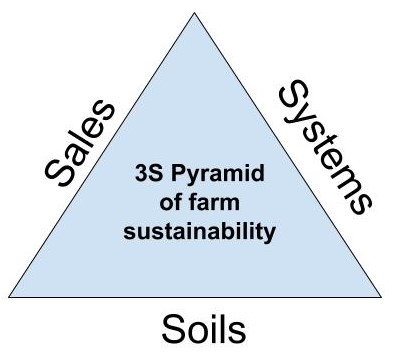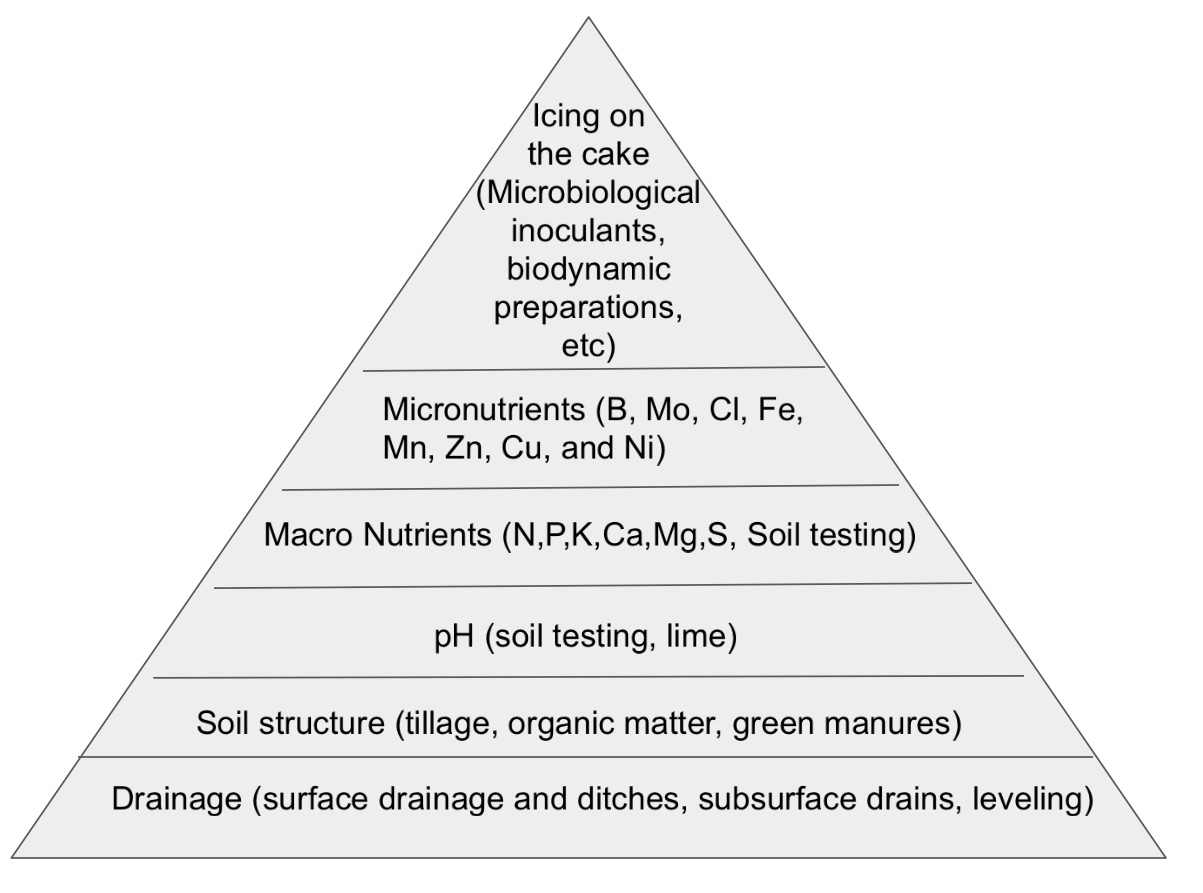Over the course of the next couple of weeks, we’ll dive deeper into each of the legs of the 3S pyramid on our quest for the triple bottom line: People, Profits, and Planet.

Soils:
Soils and soil ecosystems are the foundation of human life as we know it. The operation of a profitable and sustainable farm business is contingent on the presence of healthy, vibrant, and fertile soil ecosystems. I won’t go into detail here about soils as the organic movement is already full of knowlege on this topic. I encourage you to seek out and learn from the wealth of books and teachers out there.
I would like to highlight that there is a hierarchy of soil health factors…. that as long as the lower tiers of the soil pyramid are not solid, efforts to impact the higher tiers shall be in vain. So… don’t waste your time with microbiological activators or biodynamic preparations if your drainage is the limiting factor. Focus on addressing the weak link and a solid soil pyramid, tier by tier.

Sales:
The second leg of the triangle is sales.
Ultimately, what is important is profits. However, profits does not start with an S… just kidding. With healthy sales, profits will occur naturally when the two other legs of the triangle are sturdy. That is to say: in a farm environment with healthy soils and optimized management systems, the key elements for profitability are in place.. if and only if the necessary sales are generated.
Our businesses can only grow as far as our imaginations can reach. There is a tendency within the small farm movement to limit what we think is possible; to not dream big enough. At what ever scale you are opperating, aim to be at the upper limit of that scale without unintentionally stepping into the next scale up. To take an example from the boxing world, it is better to be a heavy light-weight boxer than a light heavy-weight boxer. Another way of seeing this is that we must seek to maximize sales for a given set of fixed costs. Your greenhouse cost $25K to build regardless of whether you manage to sell 10 000$ or 30 000$ or 50 000$ of product per year from that greenhouse. The greenhouse doesn’t give a f*** if you underperform!
Basically, what I am saying is that many farmers sell them selves short (literally) simply because they aim too low. If you’re farming 1 or 2 acres bio-intensively, you could be aiming for $150-200K in sales. If your farming in the extensive model with 5 or 6 acres in production, you could be aiming for $200-300K in sales.
Systems:
The third leg of the triangle is farm systems. A system refers to the coherent organisation of a number of components, tools, and procedures to achieve a defined outcome. When carried out in a systematic manner, the outcome of the actions in a system is greater than the sum of the parts ie. When combined in a systematic fashion, the final impact of the actions and tool is greater than what they would have achieved in an individual or haphazard manner.
Systems are both an organizational tool and an analytical tool.
Systems can often be broken down into a number of smaller systems. The farm as a whole is a system composed of a number of smaller interconnected systems
The key farm systems are:
- Information flow (planning, communication of that plan to the field, record keeping, analysis, financial planning and monitoring)
- Marketing and PR
- Pre-planting Prep (Tillage, fertilisation, drainage, field layout, crop rotation design)
- Crop Establishment (seedling production, transplanting, direct seeding)
- Crop Maintenance (Irrigation, pest + disease management, trellising, pruning)
- Weed Management (strategies, cultivation, physical barriers)
- Harvest
- Post-Harvest
- Distribution
- Maintenance and repair
- Humans (wellbeing, training, accountability, growth and developement)(farm owners, employees, interns, volunteers, managers)
In order for the whole farm to function to its full potential, each of the farm systems must be optimized and the various systems must be integrated (logically linked so as to create synergies between the various systems). For example, it is clear to see that the Weed Management system and the harvest system and linked. When the weed management system is functioning properly, harvest will be way easier than if you had to search through waist high weeds just to find your crop.